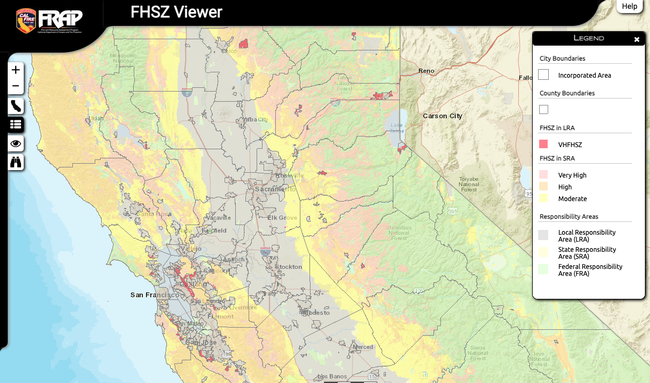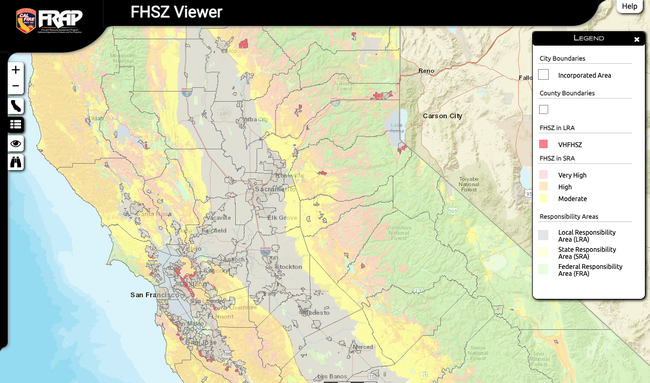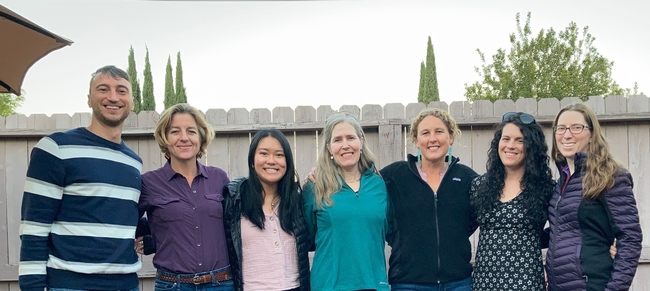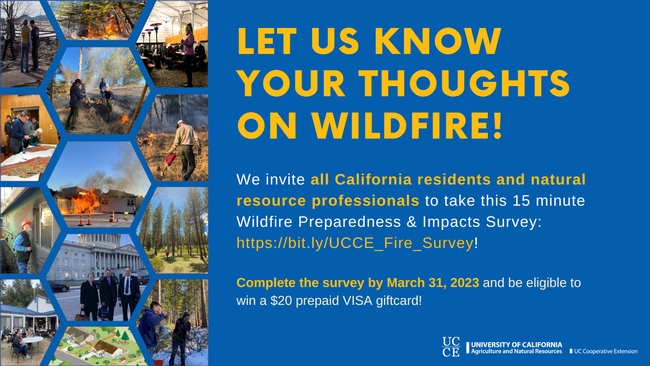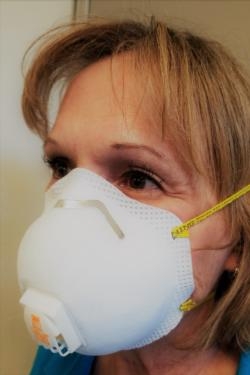Posts Tagged: Wildfire
Please complete and share wildfire defensible-space survey
The California Board of Forestry and Fire Protection has created a public survey to help develop a baseline estimate of work needed to implement Zone 0 – clearing the first five feet surrounding any structure of combustibles such as woody plants, mulch and wood fences. This will inform their economic impact analysis for the regulations, which are intended to protect homes, businesses and communities.
The board has asked UC ANR staff and academics to distribute the survey through their networks to maximize responses.
The following is suggested text for social media and email sharing:
“Your input is needed! UC Cooperative Extension is partnering with the California Board of Forestry and Fire Protection to develop a new defensible space zone for wildfire resilience within the first 5 feet of a structure, known as Zone 0. We're asking California residents and business owners to help inform cost estimates for the implementation of these new science-driven defensible space standards. Please complete the 5-10 minute survey at https://forms.office.com/g/peGA5QuDfn. It's open through April 5.”
Please complete and share wildfire defensible-space survey
The California Board of Forestry and Fire Protection has created a public survey to help develop a baseline estimate of work needed to implement Zone 0 – clearing the first five feet surrounding any structure of combustibles such as woody plants, mulch and wood fences. This will inform their economic impact analysis for the regulations, which are intended to protect homes, businesses and communities.
The board has asked UC ANR staff and academics to distribute the survey through their networks to maximize responses.
The following is suggested text for social media and email sharing:
“Your input is needed! UC Cooperative Extension is partnering with the California Board of Forestry and Fire Protection to develop a new defensible space zone for wildfire resilience within the first 5 feet of a structure, known as Zone 0. We're asking California residents and business owners to help inform cost estimates for the implementation of these new science-driven defensible space standards. Please complete the 5-10 minute survey at https://forms.office.com/g/peGA5QuDfn. It's open through April 5.”
Take 10 minutes to complete the ANR wildfire survey
By taking a brief survey, you can help UC ANR colleagues on the fire team to better understand the wildfire-related needs of Californians. While taking the survey, you'll also learn tips for protecting your home from wildfire.
The new group of Cooperative Extension fire professionals is interested in learning about the concerns of the communities and professionals already working to address these issues. Results from this survey will enhance our ability to partner with residents, landowners, agencies, academics, and other organizations to reduce California's vulnerability to wildfires.
They are asking adult residents and natural resource professionals in California to complete this survey (https://bit.ly/UCCE_Fire_Survey) by March 31.
By filling out this survey, you will help the team develop educational resources and workshops about wildfire preparedness and guide scientific research aimed at helping communities and professionals deal with wildfire risks and impacts.
This survey should take approximately 10 minutes to complete. Your participation in the survey is voluntary and your answers are anonymous. If you share your contact information in the survey, it will not be connected to your answers unless you wish to be contacted for a follow-up interview.
By participating in this study, you will have the option to enter a drawing to win one of fifty $20 VISA gift cards. Your contact information will not be linked to your answers.
This research is being led by a collaboration of UCCE Advisors and Academic Coordinator. If you have any questions about this survey, please contact your nearest fire or forestry professional involved in this survey effort:
- Luca Carmignani, fire advisor, UCCE Los Angeles, Orange, Riverside, and San Diego counties, carmignani@ucanr.edu
- Alison Deak, fire advisor, UCCE Fresno, Madera, and Mariposa counties, aldeak@ucanr.edu
- Katie Low, fire academic coordinator, UCCE Nevada and Placer counties, katlow@ucanr.edu
- Barb Satink Wolfson, fire advisor, UCCE Monterey, San Benito, Santa Clara, and Santa Cruz counties, bsatinkwolfson@ucanr.edu
- Ryan Tompkins, forestry advisor, UCCE Plumas, Sierra, and Lassen counties, rethompkins@ucanr.edu
Feel free to share the survey link with friends and clientele: https://bit.ly/UCCE_Fire_Survey.
For more information about wildfire-related programming from University of California Cooperative Extension, please visit the fire website at https://ucanr.edu/fire or the UC ANR fire Facebook page at https://bit.ly/fireSolutions.
Webinar: Helping communities recover from wildfire Sept. 29
Discuss with UC ANR colleagues programming they have done to help their local communities recover from wildfire and talk about the kinds of fire recovery outreach you'd like to do.
When: Tuesday, Sept. 29, 11:00 a.m. to noon
Registration Link: http://ucanr.edu/fireprograms
UCCE experts will give short presentations, leaving time for Q & A.
Brought to you by the UC ANR Fire Work Group.
Hear about postfire programs including:
- Wildlands and forests: Forestry Advisor Ryan Tompkins
- Fire Resilient Homes & Landscaping: Environmental Horticulture Advisor Steven Swain
- Livestock and Natural Resources: Natural Resources Advisor Tracy Schohr
- Fire Resources Website: Forestry Advisor and UCANR Fire website god Rick Satomi
New rules passed to protect workers from wildfire smoke: guidance available
Cal/OSHA recently passed an emergency regulation to establish standards to protect workers from the hazards of wildfire smoke. This standard has four primary requirements:
- Identify potential exposures to harmful air quality caused by wildfire smoke (i.e. monitor Air Quality Index (AQI) forecasts and daily levels during wildfire events).
- Communicate wildfire smoke hazards, air quality conditions, protective measures, and encourage feedback from employees.
- Train employees who are reasonably anticipated to be affected by unhealthy air quality caused by wildfire smoke.
- Control harmful exposure to outdoor workers by various methods as feasible. During unhealthy air quality events, these control measures may include working indoors in a building with filtered air, limiting the duration and intensity of outdoor work, or use of a filtering respirator when other means are not effective or practical to control exposure. The standard requires that when the AQI for PM2.5 reaches 151 or higher, the employer must make respirators available for employees to use if they must work outdoors.
UC ANR Risk & Safety Services has developed guidance and training on how to comply with this new regulation at http://ucanr.edu/protectfromwildfiresmoke as well as a PowerPoint training for safety coordinators to share with employees. Risk & Safety Services is also procuring respirators that will be shipped to all ANR locations.
“Since this is a brand-new regulation, we expect that additional guidance will come out from Cal/OSHA in the next few months,” said Brian Oatman, director of Risk & Safety Services.
In addition to this Cal/OSHA standard, a team from all UC campuses and ANR has been developing a decision matrix for guiding how UC locations will respond to unhealthy air quality due to wildfire smoke. This decision matrix will include various types of activities, such as outdoor workers, volunteers, athletics, camps, and youth activities. We will share this additional information as the decision matrix is finalized.
If you have questions about the new wildfire smoke rules, please contact Brian Oatman at (530) 750-1264 or baoatman@ucanr.edu.

